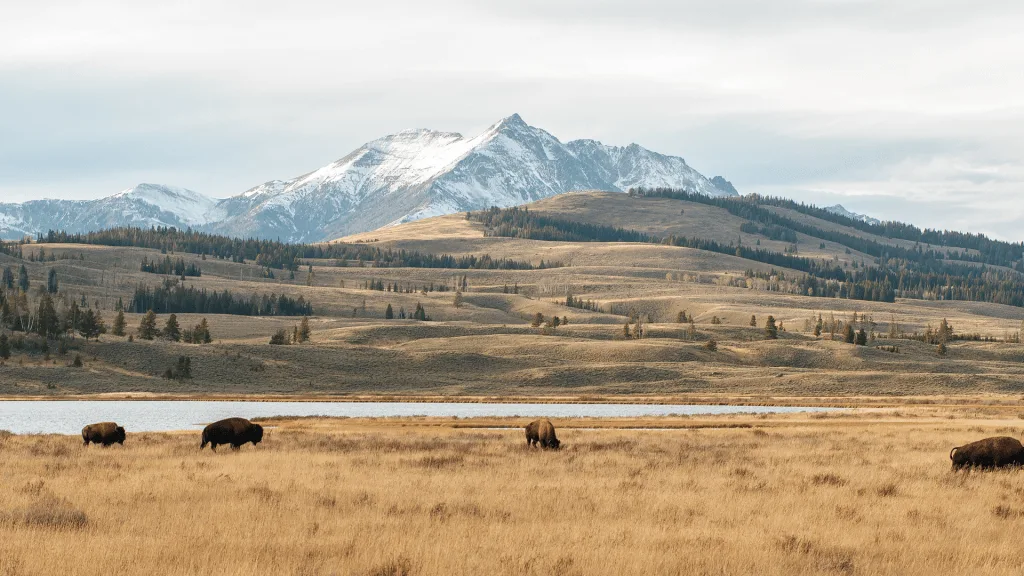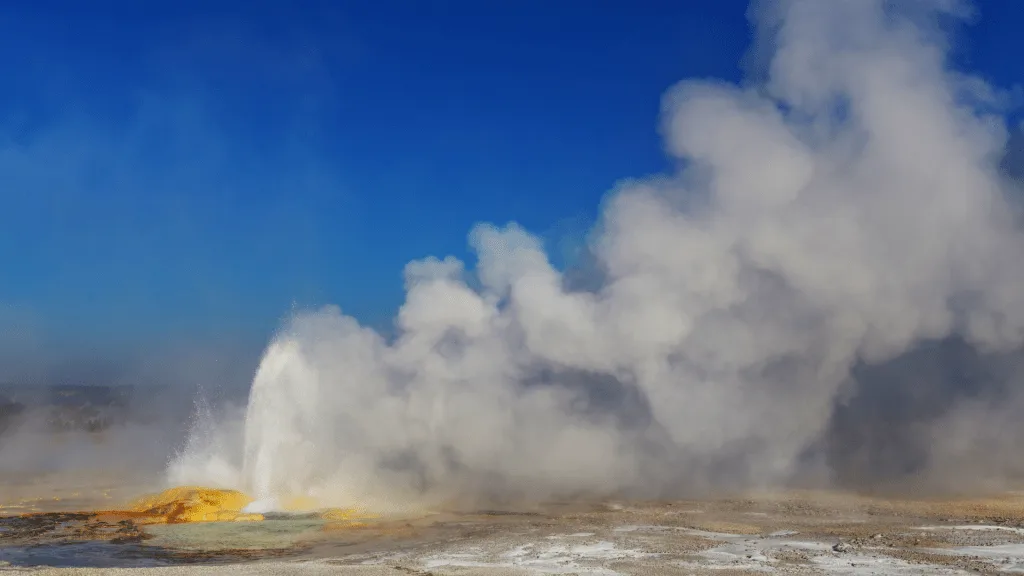Every so often, you may hear concerns about the Yellowstone volcano erupting.
Many RVers don’t know this favorite destination rests atop a supervolcano. The scenic vistas, bubbling hot pools, and fantastic wildlife are all present courtesy of the volcanic unrest.
But does that mean we may all die from a catastrophic explosion? Join us as we learn more about the geology of this fascinating region.
Let’s jump in!
What Is the Yellowstone Volcano?
President Ulysses S. Grant established Yellowstone National Park in 1872. Congress saw the value in preserving the area’s wonders based on photos, paintings, sketches, and an expedition report. It became the first national park in the world.
Yellowstone National Park is located mainly in northwest Wyoming, with a sliver in Montana and one to the west in Idaho. It’s a favorite summer destination for many RVers. Additionally, winter sports lovers enjoy the snow-covered park. It also happens to be a supervolcano.
The fascinating geysers and stellar hikes are thanks to the region’s complicated geologic history. The area today is volcanically active due to a massive caldera underlying the region, and the rocks paint a rich history of formation and destruction.
The source of the volcanic activity comes from a mantle hot spot. Like a solar flare, the hot highway brings magma to the surface over millions and millions of years. The mantle plume stays in place while continental crust slowly passes over it, leaving a trail of hot spots.
The current Yellowstone volcano has a track behind it. The oldest caldera erupted between 19 and 16 million years ago in portions of Oregon and Nevada. At least six prominent volcanic fields lie extinct across Idaho, Oregon, and Nevada.
The Yellowstone hotspot generates magma that heats the area’s geysers and hot springs. The active geology and evidence of past eruptions are why scientists monitor it today.

Who Monitors the Yellowstone Volcano?
Because much of the world’s population lives close to a volcano, scientists monitor them to understand their unique behavior. While we can’t predict when one will erupt, understanding a volcano’s features may help alert us to future events.
The Yellowstone Volcano Observatory (YVO) monitors the region’s long-term volcanic and earthquake activity. It’s a collaboration between the National Park Service, the U.S. Geological Survey, and the University of Utah. They also work with colleagues around the world.
The monitors capture real-time data the moment any events happen. Volcanologists record seismic activity and measure swelling or decreasing ground deformation. Additionally, park scientists regularly note thermal changes in the subsoil.
Other notable changes may occur in stream flows or stream temperatures. Changes in steam or gas releases around fumaroles are essential too. With today’s technology, the internet, video, GPS, and radar can provide instant information.
Pro Tip: See the Yellowstone volcano in real life by using our guide on How to Spend a Day in Yellowstone National Park.
What Is a Supervolcano?
A supervolcano could erupt with a magnitude of eight on the Volcano Explosivity Index, which is the highest level. An eruption of this magnitude can spew materials up to 240 cubic miles from the crater.
The Yellowstone volcano is a caldera. While you can’t see it from above, there’s a massive chamber full of thick, viscous, silica-rich magma about 50 miles long and 40 miles wide hiding underground. A caldera like this can create violent eruptions, spewing ash, gas, and super-heated debris (pyroclastic flows) across the landscape.
Supervolcanoes decimate the topography by ejecting their entire volume of lava. Once the magma chamber is empty, the ground collapses. The largest calderas can swallow up an area of up to 180 miles in diameter. Now you know why people are so concerned that Yellowstone might erupt. With a neighbor like that, we’d be edgy, too.
How Likely Is the Yellowstone Volcano to Erupt?
It’s certainly possible that the Yellowstone volcano will erupt someday. It’s just a question of when and how big it will be.
Currently, scientists can’t predict when an eruption may happen. Understanding individual volcanoes allows them to improve their forecasting abilities. They feel confident that a catastrophic explosion in the area is not imminent. Whew!
Geologists use the park’s volcanic history to model the likelihood of the next big blast. The last devasting blast that created a giant crater was approximately 631,000 years ago, and before that, 1.3 million.
The area isn’t without localized activity. You can find rocks from approximately 80 eruptions over the past 640,000 years. (Mostly nonexplosive lava. Yes, that’s a thing.) Changes in gas releases, temperature fluctuations, and small earthquakes are typical for the area. There’s no sign that minor lava flows are imminent either. Still, people have concerns about what would happen if Yellowstone blew.

Is Yellowstone a World-Ending Volcano?
If the park’s supervolcano erupted today, it wouldn’t end the world. Scientists have evidence of other big discharges, and man is still here. Still, if Yellowstone did explode, it would have meaningful, lasting impacts for decades.
A giant volcanic blast would destroy the three states it lies beneath. The pyroclastic ash could fall as far away as Canada, California, and the Gulf of Mexico. Ash fall pollutes water, smothers crops, and acts like cement if inhaled.
As the tiny volcanic glass particles and gas move through the atmosphere for decades, we’d experience global climate impacts. Just imagine sulfur dioxide mixed with rain to create sulfuric acid and aerosols. They reflect the sun’s heat and can cool things enough to impact agriculture. Gas and ash can also disrupt communications and the electrical grid.
Considerable changes to the environment would take place. We wouldn’t like it, but we could adapt. Man would persevere. Rather than worry about this, we should really pay attention to the current hazards at the park.
What Are the Real Hazards at Yellowstone?
Those living around Yellowstone or visiting have far more pressing things to worry about than an enormous eruption. The real dangers are the unique geologic features of the sleeping caldera.
The park’s geysers, hot springs, mud pots, and steam vents are evidence of hydrothermal activity. Cold water spreads through hot rocks and returns to the surface, creating these incredible structures.
The hottest water and steam can reach the boiling point. Countless people are severely injured or even killed by the scalding water. Even so, swimming is illegal in the thermal features, so admire it with respect from a distance.
The area is a mile above sea level, which can make some activities seem more strenuous. While the thermal features are super-hot, the lakes and rivers can cause freezing body temperatures. Other geologic threats include earthquakes that create rockslides or avalanches.
As with any wild area, learn about it before you arrive and follow the rules. You can have an enjoyable, unforgettable experience as long as you stay prepared.
Pro Tip: Use these 5 Yellowstone Camping Hacks when visiting the famous national park.
Don’t Let the Yellowstone Volcano Scare You Away
Yes, the Yellowstone supervolcano could blow at any time. Or not for hundreds of thousands or millions of years. Science shows that it’s a sleeping giant. And while it does have a scary history, it doesn’t matter because there isn’t anything we can do about it. So why wait?
The National Park Service and the U.S. Geological Survey have everything you need to know for a great trip. That’s why, despite the uncertainty, you should still include Yellowstone National Park in your RVer itinerary. The world’s first national park offers some truly incredible views.
Discover the Best Free Camping Across the USA
To be honest with you, we hate paying for camping. There are so many free campsites in America (with complete privacy).
You should give it a try!
As a matter of fact, these free campsites are yours. Every time you pay federal taxes, you’re contributing to these lands.
Become a FREE CAMPING INSIDER and join the 100,000 campers who love to score the best site!
We’ll send you the 50 Best Free Campsites in the USA (one per state). Access the list by submitting your email below: